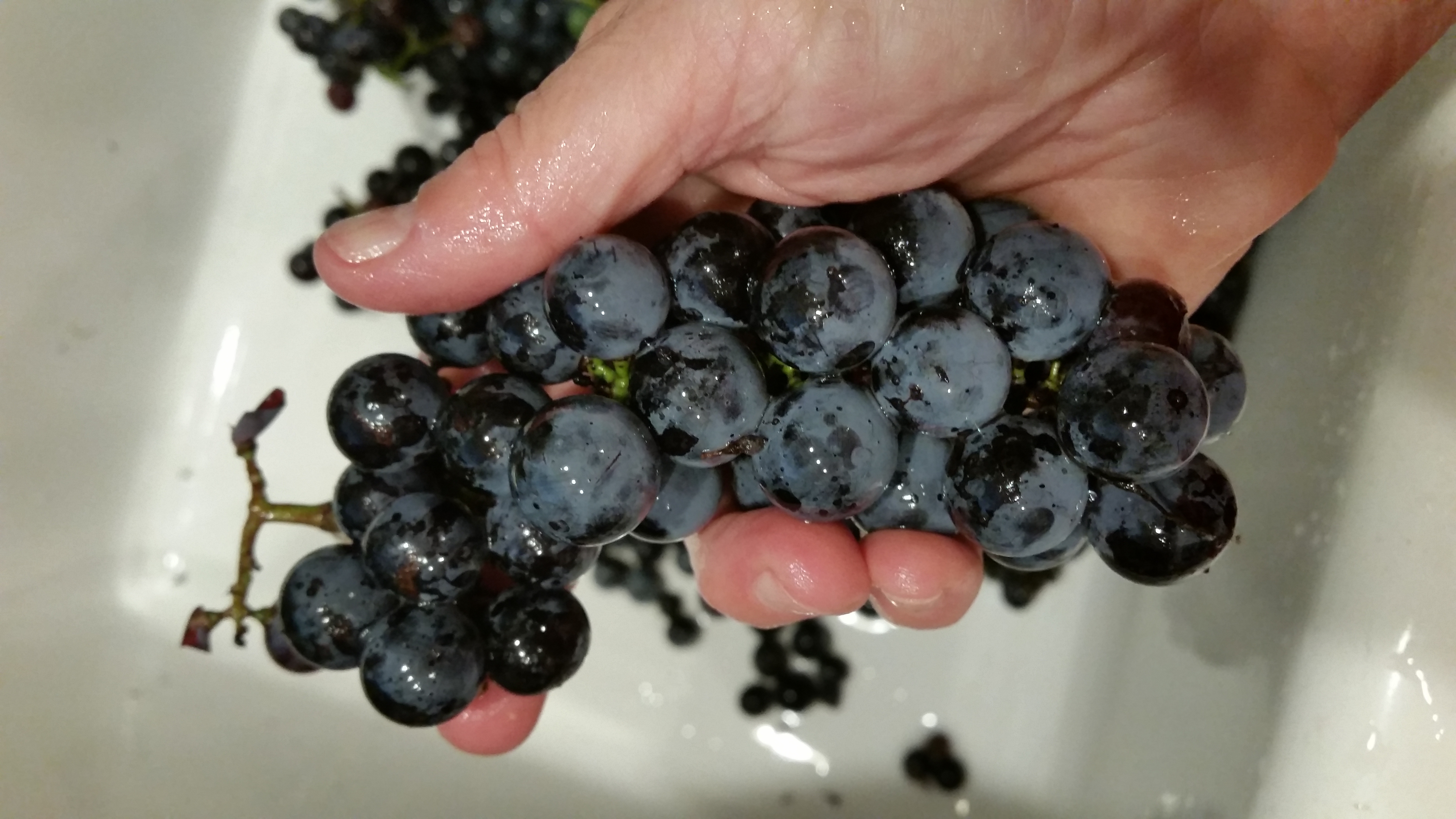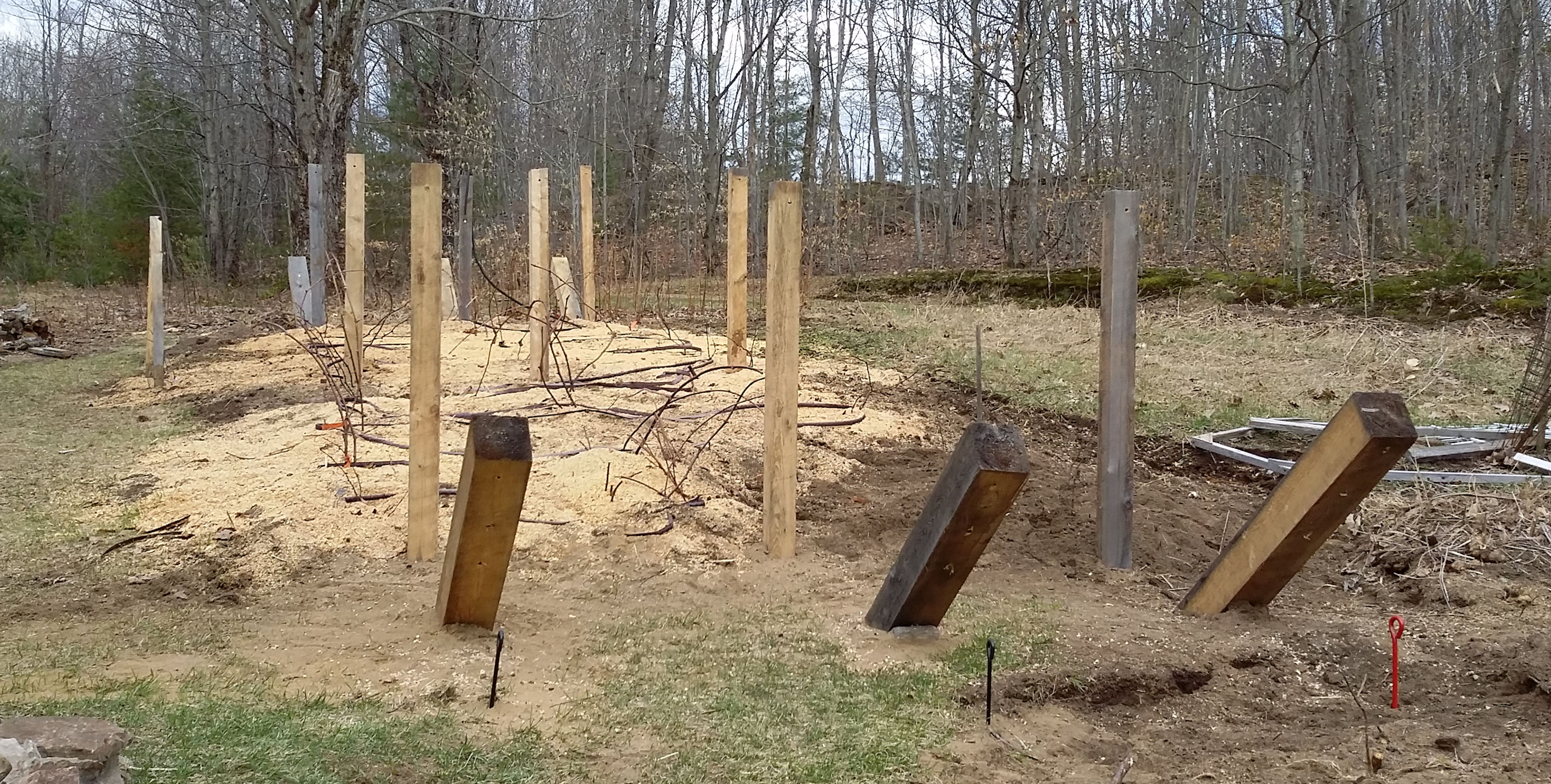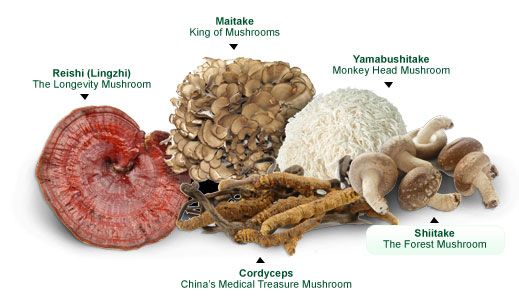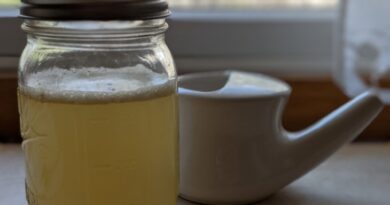Backyard Concord Grape Harvest
By Mary G. Holland
September 22, 2015
Wine or Juice?
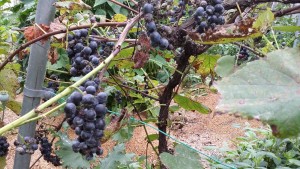
My five Concord grape vines recovered well enough from the summer’s organic powdery mildew treatment that it appeared I’d have a small harvest. I tested the Brix sugar level late August and it was only 14. It’s supposed to be 15-16 for Concords, and 22-24 for wine grapes. Sometimes if you wait until the first frost you can get a higher sugar content, so I decided to wait it out.
I read online that you can make white wine from Concords if you press and ferment without the skins. I ordered the supplies and yeast I needed in early September to make white wine, correcting for pH and sugar. I figured with a small batch I could bottle it in Hubby’s homebrew bottles.
Meantime, no frost – instead, unusually hot weather from the big El Nino. I tasted them again the morning of September 16, 2015. The flavor was full purple Concord grape taste, deeper and wilder than the full Welch’s grape juice flavor. Several grapes tested brix at 14.5 – 15 degrees, and pH 3.2 – 3.3. A couple of grapes on the fattest clusters were starting to ferment, so I’d left them almost too long. They had to be harvested. But the supplies hadn’t arrived.
I had to decide quickly whether to try to make a small batch of hopefully white wine, or whether to simply process them into grape juice as a last resort. I scrounged some older yeast we had, and Hubby had enough of other supplies in his homebrew stash that might do, until my supplies arrived, or at worst case, I could freeze or can the juice.
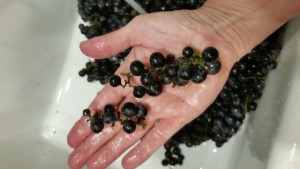 I pulled off the bad grape mummies as I harvested, and collected almost a full four gallon bucket over about 2 hours, weighing 15.4 lb. It would have taken much less time if the grapes were in better shape with less powdery mildew loss. After washing, sorting, and de-stemming, the yield was 14 lb even of just berries, another two hours later.
I pulled off the bad grape mummies as I harvested, and collected almost a full four gallon bucket over about 2 hours, weighing 15.4 lb. It would have taken much less time if the grapes were in better shape with less powdery mildew loss. After washing, sorting, and de-stemming, the yield was 14 lb even of just berries, another two hours later.
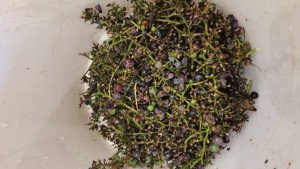
This berry plucking is a step you don’t normally have to go through with regular wine grapes, but with Concords, the extra processing is needed to avoid the “foxy” taste in wine. But time was a wastin’, it was already 1:30 pm. I grabbed lunch and moved on.
Victorio Strainer to Press Grapes? Wrong!
I haven’t purchased a fruit crusher and presser yet, but own a Victorio Strainer that had been my mother’s, purchased in the 1970s that looks like the one on this page. A week earlier, I found a “Grape Spiral” attachment online and also saw the new model with electric motor. Decided to buy the new one after reading a comparison of the two, and give it a try, figuring I could sell my old one locally if I liked the new one.
The grape spiral attachment didn’t fit my older Victorio. And sadly, the new motorized Victorio Strainer was a complete disaster, especially on grapes. I was very disappointed in its deficiencies compared to the old model:
1) The new model’s strainer cone uses a twist design instead of the older hinged threaded rods and wing nuts. The manufacturer claims this is an improvement, clearly one they didn’t actually have home processors test. Results:
a) The new strainer cone tightly screws on or off, with a set screw to hold it in place, resulting in as single, very tight tension setting. On the old one, you can adjust the cone tension to the seed size and type of skin you are straining. This is useful especially in tomato processing, where I use a looser initial setting to get all the tomatoes done quickly on the first pass, then tighten to run skins and seeds through again. The second run gets almost 25% additional thick puree. If you run it tight on the first pass it’s much more work to crank. On the new one, this tight tension caused the cone and grape spiral to clog with grape seeds and skins immediately, after pressing maybe 2 cups of grapes. It also macerated the heck out of the skins, making deep purple juice with skin pulp too. Not what I was after. In contrast on the old Victorio, I can process two to three cookie-sheet-fulls of tomatoes before the strainer clogs.
b) On the old Victorio, to remove the clogged strainer, you untwist a couple of plastic wing nuts and off pops the strainer, without handling it. On the new one, you have to use your whole hand to grasp the cone and twist it off. This is not only unsanitary, but also slippery, and it’s easy to scratch or even cut your palms on the sharp new cone screen. When it’s clogged with seeds and skins, it’s on so tight it won’t come off, hard on arthritic hands. I had to enlist the help of my husband to get the cone off. Given that was only about a pound of grapes processed, with thirteen to go, forget that. Not interested in requiring two people to do that simple task. Flaming failure.
2) I had high hopes that the electric motor would save me time and energy, but it operated slower than I could hand crank the old model, feeding the fruit or veggies with the other hand. The motor was geared down to slow speed because it just wasn’t very strong. It labored after only those two cups of grapes.
Ditch the new model. Needless to say, I washed it up, repacked it, and shipped it back for a return.
Then since my wine supplies hadn’t arrived yet, a week after ordering, I raided Hubby’s homebrew and mead making supplies, to scrounge what I could for wine making. Oops. Insufficient corn sugar, and yeast was questionable. A quick call to him while he was in town on errands, and added these to his list.
Still hung up on pressing the grapes. At this point the skins were getting soft, and hand pressing seemed to extract the purple color I was avoiding. What about simply slipping the skins off the berries? I tried that for ten minutes and ended up with half a cup of grape pulp and weary hands.
Hubby walked in, sans yeast. Double Rats. Clearly the stars were not aligned for making wine right now. I should have recognized I was pushing the energy boulder uphill.
Lazy Woman’s Way to Process Grapes
So what to do with the grapes? I’d been at this since 10am. It was now 3pm and I still had a dinner planned. But I’d invested too much into this to let go now.
OK, Go Google. I searched “make grape juice” and found an article at Mother Earth News on rapid canning of whole grapes when you’re pressed for time. Just pack the cold whole grapes in quart jars, add a tablespoon of sugar per cup, top with boling water and lids, then process in a simmering bath of water.
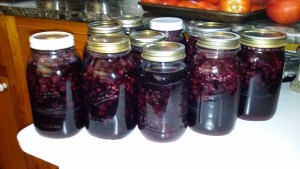
45 minutes later, with only 15 minutes of actual prep time, I had ten quarts with three cups of Concord grapes each. It does require straining at the time it’s opened to get the seeds and skins out, but at least it’s over and done with. Besides, this way the skins and seeds marinate in the juice, contributing more health properties. Each quart could be diluted to three or more at that concentration. The process went as smooth as silk. Yup this is what I was supposed to do with those darned grapes.
Grape Harvest Yield After Organic Powdery Mildew Treatment
In retrospect, the 15.4 lb. harvest yield wasn’t bad after using Actinovate and worm compost tea on the bad powdery mildew infection that hit this summer, just as we left for a ten day vacation. This treatment did manage to produce a range of results, recovering perhaps 10-15% of the grapes off each cluster on a very badly infected vine, and protected what resulted in nearly all huge, tightly bunched clusters on the least infected vine. As much as 6 lb of the yield I’m estimating came from the uninfected vine, so there is hope if I can keep these vines in better shape.
(The sad news is the mildew also hit a row of squash, then lept to the nearby wine grapes, so some of them got infected too. Treated them too later in the summer but the infection did cause leaf damage. So I’ll be going after everything next year with a weekly treatment.)

